All About Word Sums
This post may contain affiliate links. As an Amazon affiliate, we earn from qualifying purchases.
Learn all about word sums, an effective strategy for analyzing word parts to determine meaning, build vocabulary, and improve overall language skills. Get practical teaching tips and links to free morphology worksheets, too!
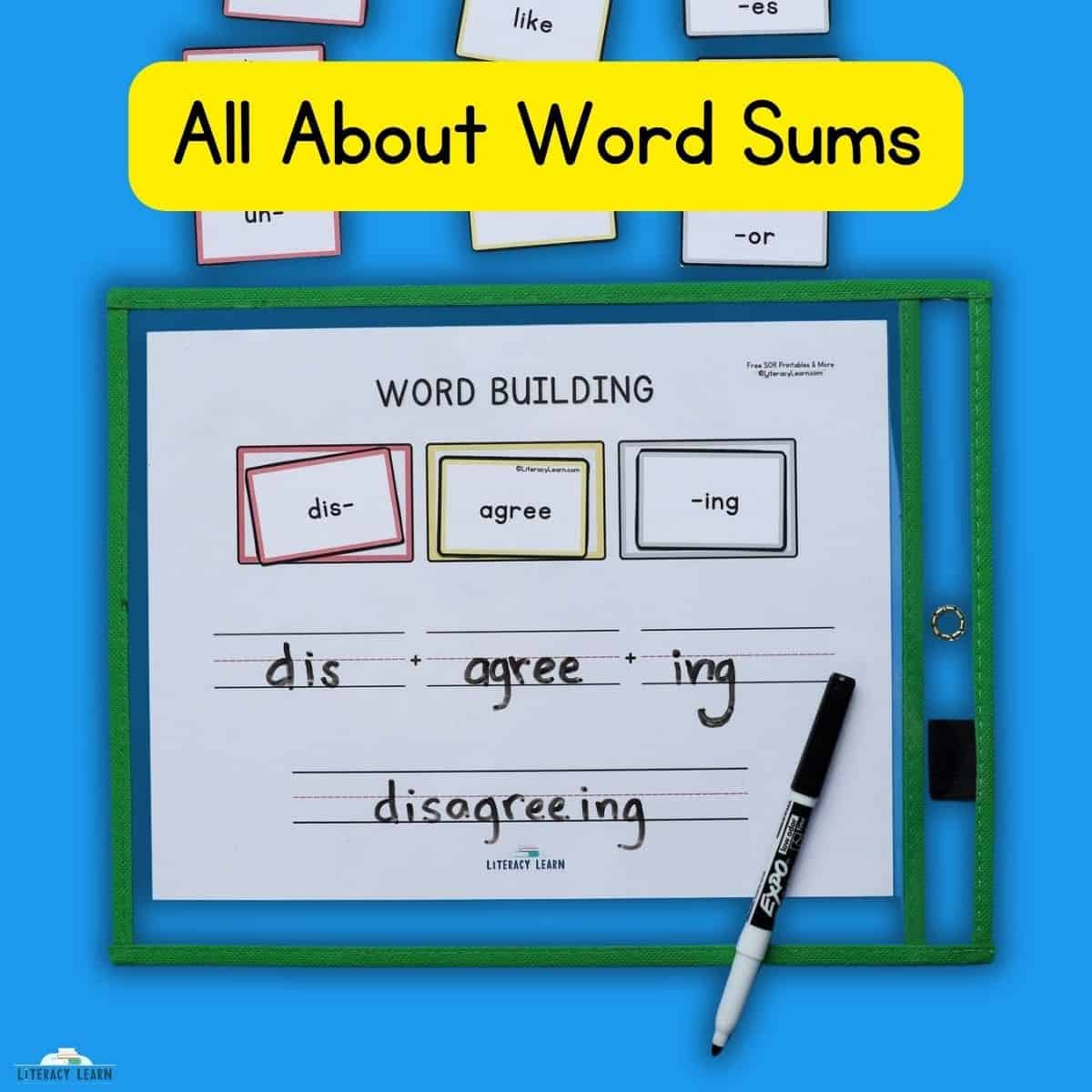
➕ What Are Word Sums?
A word sum is a visual way to show the word parts that make up multisyllabic words. Word sums show words broken apart into individual morphemes, separated by plus marks.
Word Sum Examples
- teach + er = teacher
- re + late = relate
- dark + ness = darkness
- waffle + s = waffles
- tap + ing = tapping
- cor + rupt = corrupt
- wonder + ful + ly = wonderfully
- em + ploy + ee = employee
- contra + dict + ion = contradiction
- tele + phone = telephone
- in + vade + ing = invading
- hurry + ed = hurried
- chron + ic = chronic
- geo + logy = geology
- hydr + ant = hydrant
Word sums show the word parts (morphemes) that add up to a particular word. They assist our students in recognizing that longer, multisyllabic words are comprised of smaller, meaningful components.
This understanding helps students as they read and spell words, while also providing them with insight into the word’s meaning.
How to Teach Word Sums
We teach word sums by the process of morphemic analysis. This process allows us to look at the structure of written words to determine meaning, build vocabulary, and improve language skills.
Suggested Step-by-Step Procedure:
- Be sure students have been explicitly taught the morphemes (word parts) and meanings of the word you want to investigate. If not, pre-teach and review the morphemes.
- Create a word sum by breaking the word apart and writing each morpheme. Use plus symbols to separate each morpheme.
- To create a multisensory experience, students should say the letters aloud as they write them. For example: “t-r-a-n-s (pause) p-o-r-t (pause) i-n-g.” Students pause at the word sum boundaries (plus signs) to show that they recognize the parts.
- Next, students identify the meaning of each morpheme. “Trans- a prefix that means beyond or across. Port – a Latin base that means to carry. -ing – a suffix that shows a continuing action.”
- On the next line, students put the morphemes back together, again saying each letter as they write it: “t-r-a-n-s-p-o-r-t-i-n-g (pause) transporting.”
- Finally, students state the definition. “Transporting means the action of carrying beyond or across.”
👉🏽 Using a word sum template is extremely helpful in helping kids learn this procedure. Visit our post on word parts and get free morphology worksheets, including a reusable word sum template.
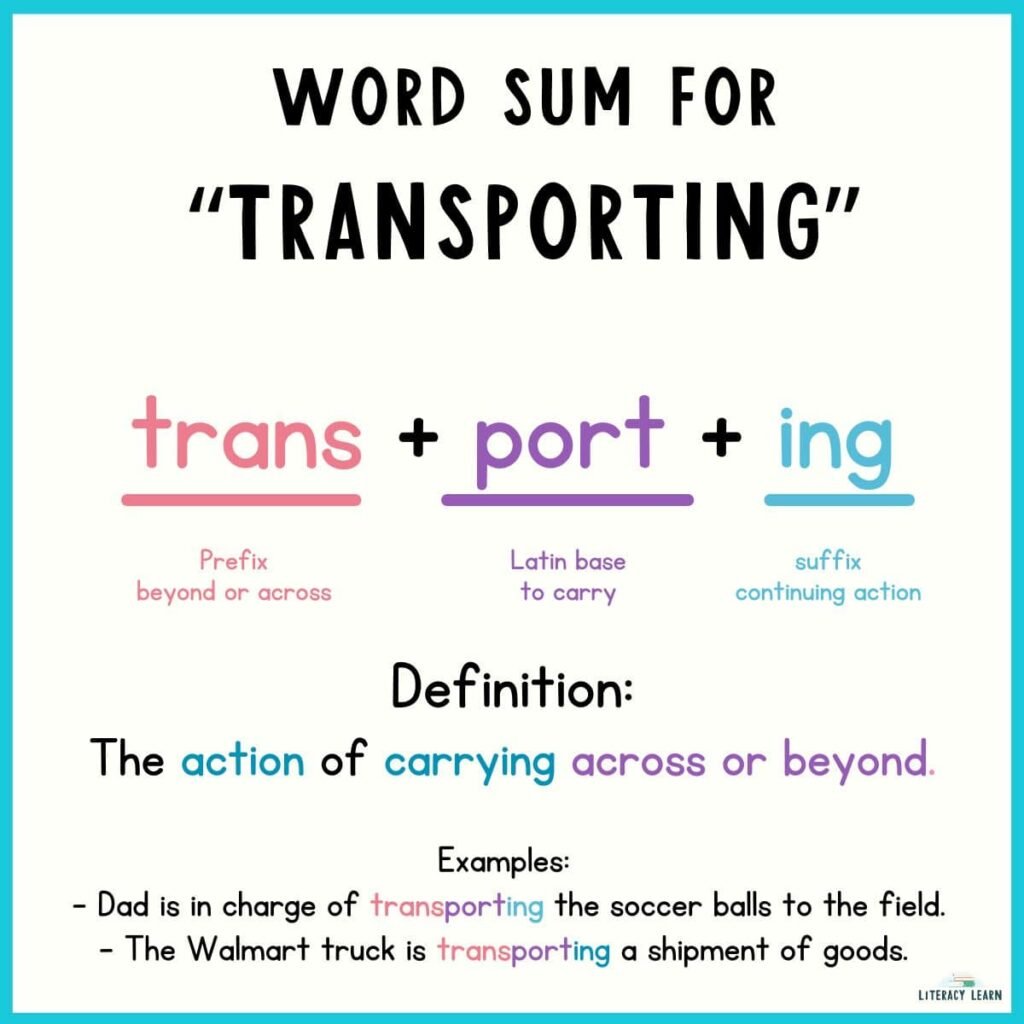
Why Morphology Matters
The English language is a morphophonemic language. What does that mean? Well…let’s look at a word sum for some answers:
morph (means: form/shape)+ o + phone (means: sound) + m + ic (means: characterized by)
Morphophonemic means “characterized by sound and form.” In this case, “form” relates to morphemes, which are meaningful units of language.
And “sound” relates to phoneme-grapheme connections. But because many words are characterized by their meaning, we cannot simply rely on teaching phonics to teach children how to read and spell.
🤔 Think about this: If you only ever teach children to sound out words when spelling, they will have a very difficult time when it comes to some words. Take the commonly misspelled word ‘does,’ for example. When kids rely on ‘sounding it out,’ they’ll likely spell something like dus, dose, duz, or duss.
Instead of sounding it out, teach kids to look at the structure (e.g. form) of the word.
The word sum would be: do + es = does
In this case, it is way more powerful for kids to understand that the word is made up of a base (do) and the suffix (-es, meaning 3rd person singular).
When we teach our students to look at words like this, we connect meaning and spelling! We can build a deep knowledge of vocabulary that will set kids up for continued success as they progress in their education.
Morphology instruction is super impactful for students with dyslexia because many tend to have weak phonemic processing skills. Teaching morphology is such a powerful tool!
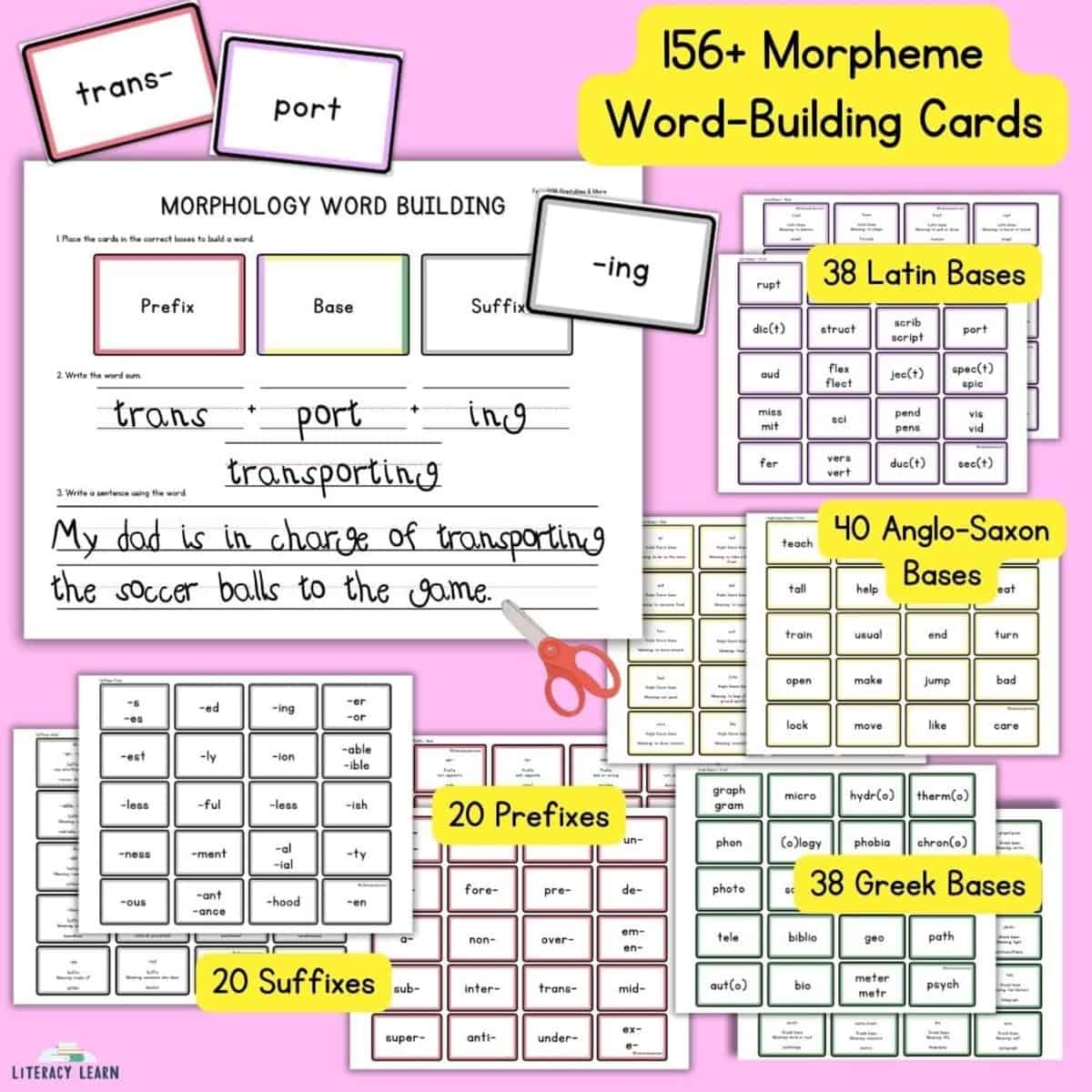
Tips for Teaching Word Sums
✨ Morphology instruction doesn’t have to be super complicated.
Kids as early as kindergarten or first grade can begin using word sums when they learn phonics concepts like suffix -s or suffix -ed.
Simply having kids break words apart into their bases and affixes (prefixes/suffixes) helps to build awareness that words have meaningful parts. For example: dog + s = dogs.
✨ If you’re introducing older students to word sums, a good idea is to start with compound words.
Compound words are made up of bound morphemes, which are pretty easy to separate.
Kids will quickly pick up on how the word’s meaning changes based on the two morphemes. For example: sunset = sun + set
✨ Greek and Latin morphemes must be taught.
Henry (1997) asserts that about 60% of English words are of Greek or Latin origin.
This will be especially important for kids’ understanding as they encounter longer, multisyllabic words within their middle and high school content-area classrooms.
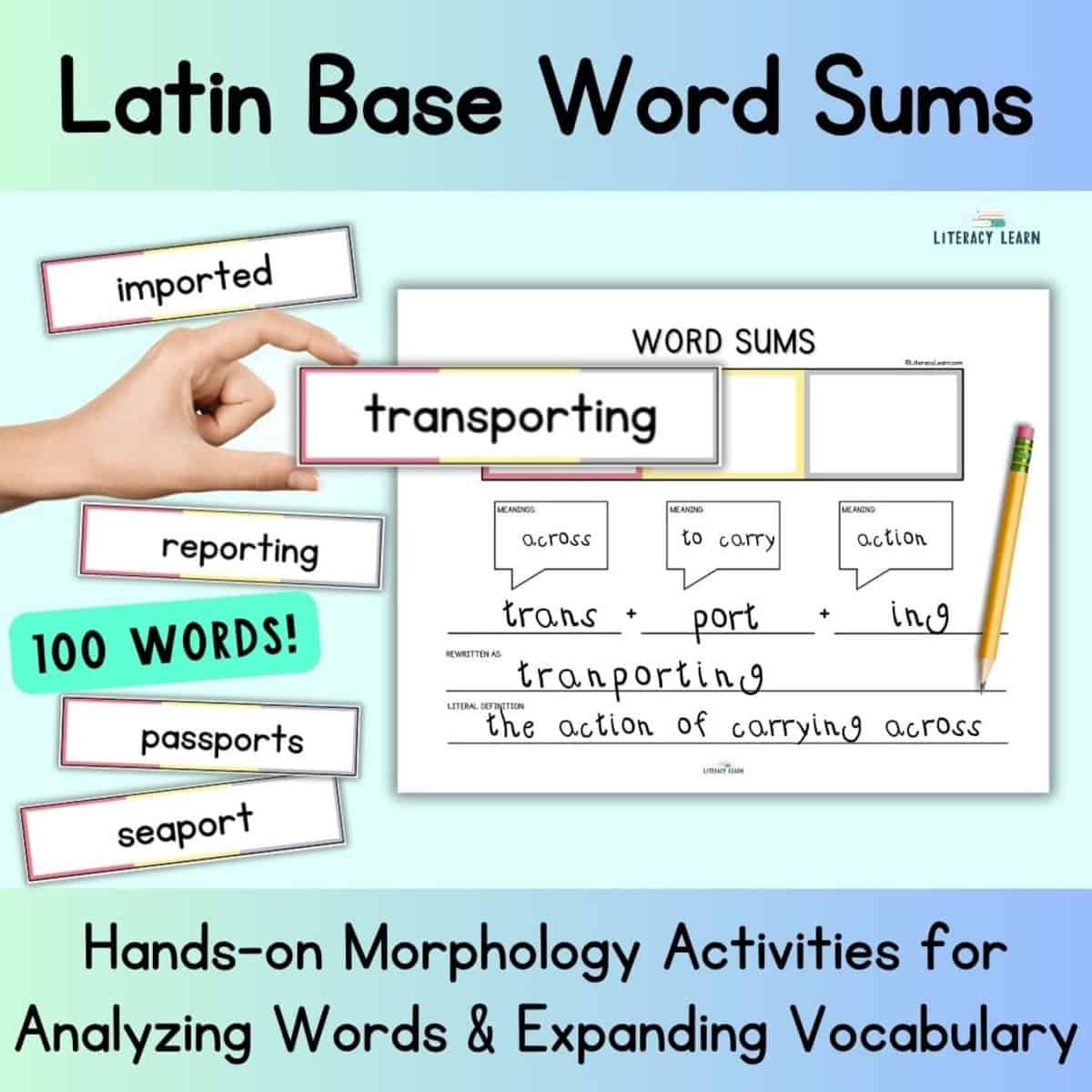
✨ Once you teach a certain morpheme and its meaning, expound on that knowledge and teach word families.
For example: the Latin root ‘spect’ means ‘see.’ Have kids brainstorm as many words as they know that include that base:
- spect + a + tor
- spec + ul + ate
- re + spect
- in + spect + or
- intro + spect
- per + spect + ive
- in + spect + ion
- pro + spect
A word matrix is an awesome tool for exploring word families. This tool requires kids to combine prefixes, suffixes, and bases in multiple ways to create new words. You can read more about morpheme exploration and get these morphology word chaining freebies, too!
✨ What if we can’t figure out all the morphemes in an English word? Can we not create a word sum? Of course we can!
Just have kids focus on the most relevant parts of the word to determine meaning. The extra bits that are added (or missing) may be a result of our language changing with usage over many centuries. Teach kids to surround the unknown parts with a plus sign and move on.
✨ Introduce students to etymonline.
This is a super helpful resource when investigating word origin and meanings. Students can utilize dictionary.com and the Oxford English Dictionary, too.
These resources help to explain some of the tricky spellings of irregular words.
✨ When completing word sums, kids will have to remember certain spelling patterns and rules, such as the doubling rule.
For example, if students do a word sum of can + ing, they must remember that the final consonant of the base word needs to be doubled (1-1-1 rule).
Teach this procedure when rewriting the word on the bottom line of the word sum. I like to teach kids to say, “c – a- n – double the n – i – n – g = canning.”
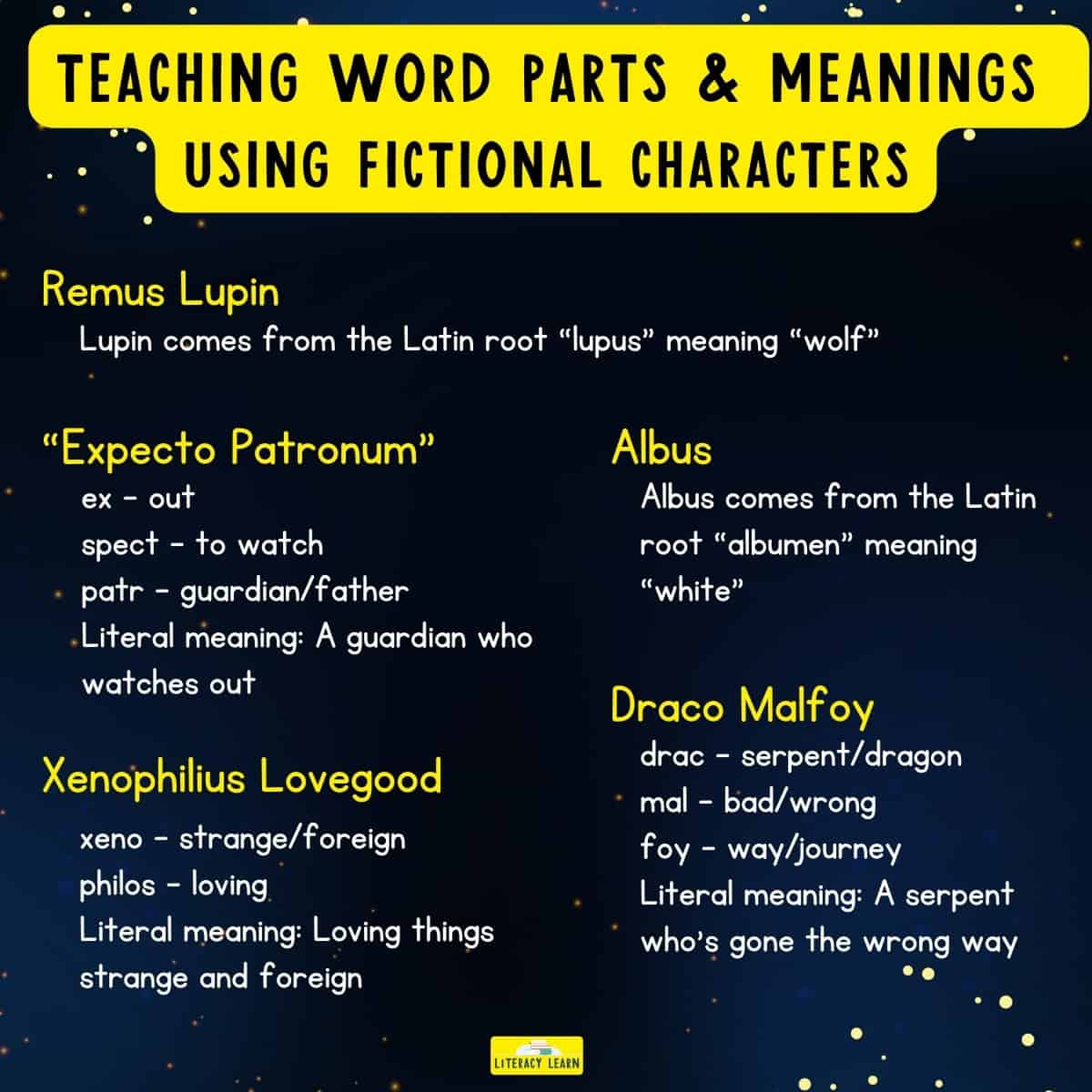
🧙🏽♂️ As a big Harry Potter fan, I like to use fictional characters to build my students’ interest in word origins and meanings. Thanks J.K. Rowling for making etymology so interesting!
So many characters, items, and charms include words with Greek and Latin roots and bases!
Let’s look at Xenophilius Lovegood, Luna’s eccentric father. If you break apart his name using a word sum, it will look like this:
xeno (means: strange/foreign) + philia (means: love) + ous
The literal definition of Xenophilius is “loving things strange or foreign.” And doesn’t that perfectly describe Xenophilius Lovegood?
We’re always looking for ways to get kids excited about learning! Using things they already know and love is the perfect way to build an interest in morphology.
Conclusion
Remember, we use word sums for two main reasons:
- They help students gain a deeper understanding of spelling.
- They help students understand the meaning of words based on the morphemes.
We hope you begin using a systematic approach to teaching morphology to support your students in these important areas of literacy.
Reference: Henry, M.K. (1997). The decoding/spelling continuum: Integrating decoding and spelling instruction from pre-k to early secondary school. Dyslexia 3.

